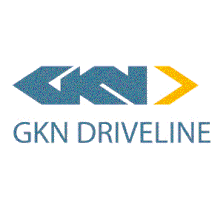GKN Driveline
GKN Automotive is the leading automotive driveline technology and systems engineer. GKN Automotive is a global partner to the automotive industry. More than 50% of the 80 million new cars sold every year contain GKN Automotive technology.
 | |
| Division | |
| Industry | Automotive |
| Headquarters | , |
Area served | Worldwide |
| Products | Automotive Components |
| Revenue | £5,308 million (2017)[1] |
| £377 million (2017)[1] | |
| Owner | Melrose PLC[2] |
Number of employees | 31,000 (2017) |
| Parent | GKN PLC |
| Website | www |
GKN has a global network of 54 production facilities in 23 countries supplies over 90% of the world's car manufacturers. It's 29,000 dedicated employees design, develop, manufacture and integrate driveline technologies that add value to vehicle programmes. GKN's manufacturing quality, advanced engineering and system integration capabilities are continuously evolving to ensure the drivelines of tomorrow meet the mobility needs of the future.
History
The origin of GKN (Guest, Keen & Nettlefolds) goes back to 1759, and the founding of the Dowlais Ironworks by the industrialists Thomas Lewis and Isaac Wilkinson.[3] It has changed shape and direction many times to hold its place in the engineering industry. The company took part in the railway boom in the early 1800s with its production of iron, then steel in the 1860s and, after the First World War, the automotive industry.
In 1966 after being advised GKN Steel would be nationalised for the second time GKN bought CVJ market leaders Birfield Industries with its subsidiaries Hardy Spicer and Laycock Engineering with their interests and subsidiaries in Europe, Japan and the United States to save its BRD subsidiary.[4] It was the start of the company's globalization. GKN established a manufacturing presence in China in 1988. At the same time GKN Driveline was investing in and growing its business in India, Brazil and Mexico.
(Divisions) Products, Research and Development
CVJ Systems
A CVJ, or constant velocity joint, transfers power from the transmission to the front wheels, allowing articulation and movement for steering and suspension.[5] The three major elements are: inboard and outboard CVJs, including lubrication and sealing systems, and interconnecting shafts. The inboard joint is a plunging joint that allows the effective length of the sideshaft to adjust due to suspension movement. The outboard joint needs to transfer power effectively through a wide range of angles (up to 53 degrees).
AWD Systems
AWD Systems are for all-wheel drive (AWD) vehicles.[6] GKN Driveline has unique developments for partial or full AWD vehicles. Within AWD Systems, GKN Driveline offers one, two or three-piece high speed propshafts made from steel, aluminium or composite tubes. Forefront example of this technology is used in the custom made to order by Ford Performance for the Ford Focus RS launched in 2016.[7] It utilizes an intelligent torque vectoring AWD system with rear differentials. This AWD system is also used in various vehicles by GM, Volvo and other car manufacturers.[8][9]
Trans Axle Solutions
Trans Axle Solutions cover an extensive range of Open Differentials, Limited Slip and Locking Differentials, and advanced products like electronic torque vectoring.[10] The wide range of differentials available is used in passenger cars, Sports car (SUVs) and Light truck. Limited Slip and Locking Differentials are designed to improve vehicle traction and handling performance on all surfaces and under all driving conditions. They ensure driving and braking power is effectively distributed across the axle to the wheels, therefore providing unsurpassed levels of stability, handling, traction and overall vehicle control.
eDrive
eDrive Systems are the solutions from Driveline that "include advanced technology centered on continuous improvement and innovation in the application of alternative power and sustainable energy in systems that deliver performance."[11] Notably, the families of eAxles and eTransmissions:
eAxles support the electrification of a vehicle as secondary driven axle while the primary engine is still a combustion engine and therefore can be disconnected. eTransmissions manage the torque on the primary axle of fully electrified vehicles.
The eAxle drive module is a compact, lightweight Gear with an actively controlled wet clutch for electric motor assisted AWD. The eAxle unit for axle split Hybrid electric vehicle incorporates a proprietary disconnect clutch technology, which facilitates on-demand all-wheel-drive (AWD) use and contributes to the overall all-terrain functionality and fuel efficiency.
Electric drive transmissions can transmit up to 300 kW of power, they are available with ratios up to 14:1 and can be matched with E-motors from various suppliers to allow flexible application.
References
- (PDF). GKN plc http://www.annualreports.com/HostedData/AnnualReports/PDF/LSE_GKN_2017.pdf. Retrieved 12 December 2017. Missing or empty
|title=(help) - https://www.melroseplc.net/. Missing or empty
|title=(help) - Andrew Lorenz, "GKN. The Making of a Business 1759-2009", 2009
- Andrew Lorenz, GKN, the making of a Business, Wiley UK, 2009 ISBN 9780470749531
- "GKN Driveline CVJ Overview". GKN plc. Retrieved 25 April 2014.
- "GKN Driveline AWD Overview". GKN plc. Retrieved 25 April 2014.
- "The 2016 Ford Focus RS Gets an Advanced Torque-Vectoring AWD System". Automobile magazine. Retrieved 14 April 2018.
- "GKN: Drifting, from AWD to eAWD". The Virtual Driver. Retrieved 14 April 2018.
- "GM seeks a market beyond the snow belt for awd models". Automotive News. Retrieved 14 April 2018.
- "GKN Driveline Trans Axle Overview". GKN plc. Retrieved 25 April 2014.
- "GKN Driveline eDrive Overview". GKN plc. Retrieved 25 April 2014.
Bibliography
- Lorenz, Andrew: GKN.The Making of a Business 1759-2009. John Wiley & Sons Ltd (2009)
- Jones, Edgar: A History of GKN. Volume One: Innovation & Enterprise 1759-1918. GKN plc (1987)
- Jones, Edgar: A History of GKN. Volume Two: The Growth of a Business 1918-1945. GKN plc (1990)
- GKN plc factsheet: http://www.gkn.com/media/Documents/GKNfactsheet_final.pdf, 12.08.2011